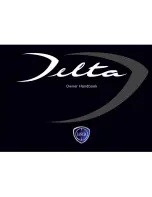
JUMP-STARTING PROCEDURE
WARNING!
•
Do not attempt to push or tow your vehicle to get it started.
Vehicles equipped with an automatic transmission cannot be
started this way. Unburned fuel could enter the catalytic
converter and once the engine has started, ignite and damage
the converter and vehicle. If the vehicle has a discharged
battery, booster cables may be used to obtain a start from
another vehicle. This type of start can be dangerous if done
improperly, so follow this procedure carefully.
•
Battery fluid is a corrosive acid solution; do not allow battery
fluid to contact eyes, skin or clothing. Don’t lean over battery
when attaching clamps or allow the clamps to touch each
other. If acid splashes in eyes or on skin, flush contaminated
area immediately with large quantities of water.
•
A battery generates hydrogen gas which is flammable and
explosive. Keep flame or spark away from the vent holes. Do
not use a booster battery or any other booster source with an
output that exceeds 12 volts.
•
Take care to avoid the radiator cooling fan whenever the
hood is raised. It can start anytime the ignition switch is on.
You can be hurt by the fan.
When jump starting, proceed as follows:
1. Wear eye protection and remove any metal jewelry
such as watch bands or bracelets that might make an
inadvertent electrical contact.
2. When boost is provided by a battery in another
vehicle, park that vehicle within booster cable reach and
without letting the vehicles touch. Set the parking brake,
place the automatic transmission in PARK and turn the
ignition switch to the OFF position for both vehicles.
3. Turn off the heater, radio and all unnecessary electrical
loads.
4. Connect one end of a jumper cable to the positive
terminal of the discharged battery. Connect the other end
of the same cable to the positive terminal of the booster
battery.
WHAT TO DO IN EMERGENCIES
399
6
Summary of Contents for 2008 Caravan
Page 3: ......
Page 6: ...INTRODUCTION 5 1...
Page 9: ......
Page 125: ...124 UNDERSTANDING THE FEATURES OF YOUR VEHICLE...
Page 126: ...UNDERSTANDING THE FEATURES OF YOUR VEHICLE 125 3...
Page 127: ...126 UNDERSTANDING THE FEATURES OF YOUR VEHICLE...
Page 221: ...BASE INSTRUMENT CLUSTER 220 UNDERSTANDING YOUR INSTRUMENT PANEL...
Page 222: ...PREMIUM INSTRUMENT CLUSTER UNDERSTANDING YOUR INSTRUMENT PANEL 221 4...
Page 305: ......
Page 335: ...334 STARTING AND OPERATING...
Page 395: ...Jack Location 394 WHAT TO DO IN EMERGENCIES...
Page 405: ......
Page 409: ...3 3L 3 8L ENGINE COMPARTMENT 408 MAINTAINING YOUR VEHICLE...
Page 461: ......
Page 469: ......
Page 479: ......
Page 480: ...INDEX 10...
















































